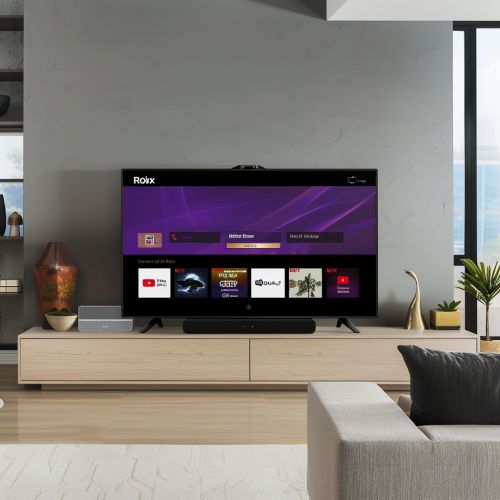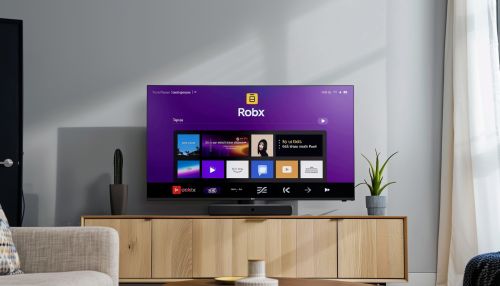Roku TV
Introduction
Roku TV is a brand of smart televisions that integrates the Roku streaming platform directly into the television set. This integration allows users to access a wide range of streaming services, including Netflix, Hulu, Amazon Prime Video, and many others, without the need for an external streaming device. Roku TVs are manufactured by various television brands under license from Roku, Inc., and they offer a user-friendly interface, a comprehensive app store, and a variety of features designed to enhance the viewing experience.
History
The concept of Roku TV emerged from the success of Roku's standalone streaming devices, which were first introduced in 2008. Roku, Inc., founded by Anthony Wood, aimed to simplify the process of streaming content over the internet. The first Roku TV models were launched in 2014, in partnership with television manufacturers such as TCL and Hisense. These early models were well-received for their ease of use and affordability, setting the stage for Roku TV's continued growth and evolution.
Technology and Features
Roku TV sets are equipped with a range of technologies and features that make them competitive in the smart TV market. These include:
Operating System
Roku TV runs on the Roku OS, a proprietary operating system designed specifically for streaming media. The Roku OS is known for its intuitive interface, which organizes content into a grid of app icons, making it easy for users to navigate and find their desired streaming services.
Streaming Channels
One of the key features of Roku TV is its extensive library of streaming channels. The Roku Channel Store offers thousands of channels, including major streaming services, niche content providers, and free ad-supported channels. This wide selection ensures that users have access to a diverse range of content.
Voice Control
Many Roku TV models come with voice control capabilities, either through the included remote control or via integration with voice assistants like Amazon Alexa and Google Assistant. This feature allows users to search for content, launch apps, and control playback using voice commands.
4K and HDR Support
Roku TV supports 4K resolution and High Dynamic Range (HDR) content, providing enhanced picture quality with greater detail and more vibrant colors. This makes Roku TV an attractive option for consumers looking for high-quality viewing experiences.
Mobile App
The Roku mobile app, available for iOS and Android devices, offers additional functionality for Roku TV users. The app can be used as a remote control, to cast content from a mobile device to the TV, and to access private listening mode, which allows users to listen to TV audio through headphones connected to their mobile device.
Regular Updates
Roku regularly updates its operating system to introduce new features, improve performance, and enhance security. These updates are automatically pushed to Roku TV devices, ensuring that users always have access to the latest advancements.
Market Position and Competition
Roku TV competes in the smart TV market against other major brands and platforms, including Samsung's Tizen, LG's webOS, and Google's Android TV. Each of these platforms has its own strengths and weaknesses, but Roku TV is often praised for its simplicity, affordability, and extensive content library.
Partnerships
Roku has established partnerships with several television manufacturers, including TCL, Hisense, Sharp, and RCA. These partnerships allow Roku to offer a wide range of TV models at various price points, catering to different consumer needs and preferences.
As of recent years, Roku TV has gained a significant share of the smart TV market, particularly in North America. Its success can be attributed to its user-friendly interface, competitive pricing, and strong brand recognition.
User Experience
Roku TV is designed to provide a seamless and enjoyable user experience. Key aspects of this experience include:
Easy Setup
Setting up a Roku TV is straightforward, with on-screen instructions guiding users through the process of connecting to Wi-Fi, linking their Roku account, and downloading their preferred streaming channels.
Customizable Home Screen
The home screen of Roku TV can be customized to suit individual preferences. Users can rearrange app icons, add or remove channels, and personalize the background theme.
Universal Search
Roku TV features a universal search function that allows users to search for content across multiple streaming services simultaneously. This feature helps users find the best available options for the content they want to watch, including free and subscription-based sources.
Private Listening
Private listening mode, accessible through the Roku mobile app, allows users to listen to TV audio through headphones. This feature is particularly useful for late-night viewing or for those who prefer a more immersive audio experience.
Parental Controls
Roku TV includes parental control options, enabling parents to restrict access to certain channels and content based on ratings. This ensures that children can only access age-appropriate material.
Technical Specifications
Roku TV models vary in terms of technical specifications, depending on the manufacturer and model. Common specifications include:
Display
Roku TVs are available in various screen sizes, ranging from small 24-inch models to large 75-inch models. They offer different display technologies, including LED, QLED, and OLED, with resolutions ranging from Full HD to 4K Ultra HD.
Connectivity
Roku TVs come with multiple connectivity options, including HDMI ports, USB ports, Ethernet, and Wi-Fi. These options allow users to connect external devices such as gaming consoles, Blu-ray players, and soundbars.
Audio
Audio quality varies across Roku TV models, with some offering basic stereo sound and others featuring advanced audio technologies like Dolby Atmos. Many models also include optical audio output for connecting to external sound systems.
Processing Power
Roku TV models are equipped with different levels of processing power, affecting their performance and responsiveness. Higher-end models typically feature more powerful processors, resulting in smoother navigation and faster app loading times.
Future Developments
Roku continues to innovate and expand its offerings in the smart TV market. Future developments may include:
Enhanced AI Integration
Roku is likely to further integrate artificial intelligence (AI) into its platform, improving voice recognition, personalized content recommendations, and automated content discovery.
Expanded Content Partnerships
Roku may continue to expand its content partnerships, bringing more exclusive and original content to its platform. This could include collaborations with major studios, independent creators, and international content providers.
Advanced Display Technologies
As display technology evolves, Roku TV is expected to adopt new advancements such as MicroLED and 8K resolution. These technologies will offer even higher picture quality and more immersive viewing experiences.
Improved Gaming Capabilities
With the growing popularity of cloud gaming services, Roku TV may enhance its gaming capabilities, providing better support for game streaming platforms and integrating features like low-latency modes and advanced graphics processing.
Conclusion
Roku TV has established itself as a leading player in the smart TV market, offering a user-friendly interface, extensive content library, and a range of features that enhance the viewing experience. Its success is driven by strategic partnerships, continuous innovation, and a focus on delivering value to consumers. As the smart TV landscape continues to evolve, Roku TV is well-positioned to remain a popular choice for streaming enthusiasts.


